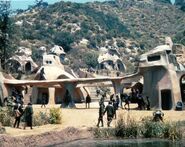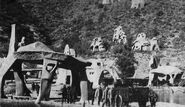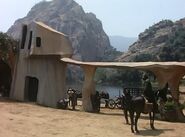Ape City was the home of an ape society encountered by George Taylor after his arrival on a future Earth.
History[]
The city was ruled by an orangutan elite headed by a President, although the most influential figure was Zaius the Minister of Science and Chief Defender of the Faith. Ape City, along with the rest of the world was later destroyed following the detonation of the Alpha-Omega Bomb.
Feature[]
It took the form of clusters of adobe structures, without any uniform shape, which were spread across the side of a hill overlooking a river or lake some distance from the Forbidden Zone and the ruins of New York City.
Known Locations[]
- Amphitheater - A location for entertainment or a city meeting.
- Chapel/Schoolhouse - A place where Ape City's citizens go for their education.
- Lawgiver Shrine - A shrine that is dedicated to the Lawgiver.
- Ministers' Offices - The offices of Ape City's ministers.
- National Academy - An academy where the chimpanzee doctors and scientists work.
- National Academy Hearing Room - The orangutans hold different hearings in this room.
- National Academy Labs - The Chimpanzees do their research here.
- National Academy Museum - The ape artifacts and taxidermy humans are located here.
- National Academy Offices - The offices of the National Academy staff.
- Police Headquarters - Headquarters of the Gorillas that work as Ape City's Police Force.
- Postal Services -
Known Inhabitants[]
- Doctor Zaius
- Doctor Zira
- Doctor Cornelius
- General Ursus
- Lucius
- Julius
- Doctor Milo
- President Gaius
- Doctor Maximus
- Honorius
- Doctor Galen
- Minister Sabian
- Marcus
- Mungwortt
- Zao
- Liet
- Malia
- Sata
- Kenya
- Jaffe
- Zaius (Marcus Son)
- Gorilla Child
- Gorilla Photographer
- Hunt Leader
- Minister
- Quintus
Behind the Scenes[]
When Michael Wilson was hired to rework Rod Serling's script for Planet of the Apes at the end of 1966, his most commonly highlighted change to the story was in the portrayal of the Ape City. Serling's screenplays had all involved the type of modern metropolis backdrop found in the source novel. Producer Arthur P. Jacobs had wisely employed set-designer William Creber as Art Director, and he was given the task to design the city in which the intelligent apes lived. When Creber began preliminary sketches of the simian city, he kept with Serling's modernistic style of habitations which Pierre Boulle described in his book. However, the producers couldn't simply use a real city for location shooting (though they would later do just that on both Escape and Conquest) because location scenes would have to have been filmed either early in the mornings, or at other times when crowds would not have hampered the film. As time went on - and production costs continued to mount - the idea of such a complex setting was abandoned in favor of the simple, less-complicated hut dwellings. The idea was put forward that a primitive city would be less costly to build and would therefore save money better used in the make-up department. To the always cost-conscious studio front office, this decision allowed for a couple of million dollars to be shaved off the already astronomical budget. While the primitive setting of the ape culture scarcely made more than cosmetic changes to the actual story, it probably helped to distinguish the movie with it's iconic city and costumes.
For Wilson's interpretation of the story, the apes had to be like humans, but very different in some ways. They were satires on humanity rather than simply "humans with ape faces"; a flawed mimicry of modern human society. And if the apes themselves had to be satirical in appearance, then their cities would have to be designed to share that appearance. In addition, the twist ending retained from Serling's earlier screenplays - that the planet was in fact Earth - required the audience not to recognise the planet as their own. Twentieth Century Fox-commissioned artists started studying ancient cliff dwellings, partially carved from solid stone in mountainsides. William Creber's "objective was to find something really original and different, in line with and opposed to Pierre Boulle's concept, which took place in a contemporary environment. But when the idea came up for the Statue of Liberty shot, it became apparent that we needed to provide a concept that wouldn't give away that they might be on Earth, in order to reinforce its dramatic impact. We explored all ideas, even of shooting in Brasilia, and use a strange, modern aspect. Arthur Jacobs didn't buy that at all, although he liked the sketches. We looked at... a Turkish city of cave dwellers called Goreme Valley, and these concepts came through a little, but we really had no structural idea in mind."[1]
The designs were completed on paper, but moved away from the mountainside structures. After all, apes had started out as tree-dwelling animals, and would naturally seek to live out in open areas. Michael Wilson helped come up with the more economical design for an Ape City: "We wanted to find an architectural style for the apes culture which would look quite unlike anything people had ever known in America and yet didn't seem futuristic or phony or anything. I came up with a suggestion. There's a Spanish architect named Antonio Gaudi, who is considered a great man in Spain and has some marvelous architecture there. His architecture suggests a kind of arborial past; some of the columns of his buildings seem like giant trunks of trees. I took this to the art director and he agreed that this was inspirational. So the city of the apes in the picture was built in that fashion. Which suggested that these people were - well, trees were nostalgic to them for having lived in them at one time."[2] William Creber credited artist Mentor Huebner with much of the iconic city's design: "The challenge was to make up a style of life that these people might have developed because they would be strong, good with their hands. We kind of invented an architecture that was as far from anything Earth-like as we could go. We were inspired by Gaudi, and the Goreme Valley in Turkey. I had an artist, Meutner Hubner [sic], a very famous and fine motion picture illustrator, putting all those pieces of research together to get a look, having no idea how we would ultimately build it."[3]
All buildings, from private dwellings to important government museums and scientific centres, were designed with the same outward appearance. Each had a starting framework of squares, or rectangles, or other simple geometric shapes. Windows were of the same general shape as the entire structure. Any 'chimneys' were part of the roof, that side of the building just extended to be a little taller. These designs were taken and changed, until it appeared that wax models had been made and partially melted. The apes' city began to take on a definite, individualized 'look'. It was unique and surrealistic in appearance, like nothing that had ever been designed before. 'Bridges' were designed to connect all the buildings. These were winding or straight ledges up above ground level. Rooms were large, though not well-lit. Originally, the furnishings were designed as separate pieces, but ultimately they were reworked so that they almost seemed to spring from the floors and walls. Independent tables and chairs were altered to look like the same irregular patterns that formed the houses. A good example of this are the beds in the dissection room, and the tables of the main courtroom. In earlier sketches they can easily be seen to be separate structures, whereas in later versions they appear to be sprouting from the rooms themselves. The technology, too, kept changing. In some of the early storyboards, even after the general appearance of the ape city was designed, clumps of streetlamps can be seen. The final reasoning was that, if the apes' society was one run on the idea that progress was evil (humans killed the Earth of years ago with scientific warfare, so both humans and progress were something to be avoided), then their lifestyle would reflect this philosophy.[4]
The huge Ape City set, with it's many buildings, public squares, streets, shoreline, huge outdoor amphitheater and stockade, was built in April/May 1967 on the Fox studio's ranch near Malibu, California. An area of the ranch was cleared for the city and was landscaped with odd-looking plants. Along with shrubbery, entire trees from exotic climates were replanted in the hills surrounding the city. Foundations were made of wooden beams and wires, and the surfaces of the houses were completed in plaster, polyurethane foam (a chemical mixture resembling bread dough, which could be sprayed from a gun, easily molded into any desired shape, and which hardened into a cement-like consistency), and fibreglass.[4] Creber recalled, "the studio at the time had been experimenting with a substance called polyurethane foam, and one day, some fellows had attempted to build something with this foam by spraying it on cardboard, and it had the exact look we were after. So we sculptured the buildings, using 1/4 inch models, with welded rod, covered with cardboard and they’d spray them with foam. Towards the end, we didn't have enough equipment, and we weren't making good time, so we had to go into plaster and cement construction, plus the foam. It worked pretty satisfactorily though."[1] On the outskirts of the city, some buildings were built a little smaller than the other houses. This is known as building in 'forced perspective', and is common to save time and construction costs. Hardly a movie set is made that doesn't have some part of it built deliberately out of proportion. Up in the hills surrounding the city, even smaller buildings were completed. These were included to give the impression of the city continuing for a much greater distance than it actually did. All the buildings were spray-painted a light shade of brown, to further the illusion they were made from stone. Glass windows were positioned inside of certain of the structures, and the 'bridges' were carefully worked into the buildings themselves. Although most of the buildings were completed just to be seen on camera, there were certain ledges and sections that had to be reinforced so that they could take the weight of actors. During various scenes in the film, apes could be seen scampering along from building to building. And, in one scene, Charlton Heston was hoisted high into the air, in a net supported on a connecting 'bridge'. Landscaping completed the picture. The small piece of land that was the site of the 'Lawgiver' statue received very careful attention. The result was a speedy, economical and realistic village.[4]
The city was refurbished for use again two years later, for Beneath the Planet of the Apes in 1969. Despite the intense rains and mud slides suffered by Southern California the preceding winter, resulting in extensive damage to the exterior set, its foundation and basic structural engineering were sound enough to withstand the elements. As can be seen in Beneath, however, a little of the 'Ape City' set was gone by then. In the TV show episode The Gladiators, shot in June 1974, only the amphitheater section was left. Even this was finally demolished in the late 1970s.
Notes[]
- In the original shooting script for Planet of the Apes, Ape City was referred to as 'Apetown'.
Image Gallery[]
External links[]
References[]
- ↑ 1.0 1.1 'Cinefantastique Planet of the Apes Issue' (1972) at Hunter's Planet of the Apes Archive
- ↑ 'Marvel's Planet of the Apes', USA Issue 2 (October 1974)
- ↑ The Planet of the Apes Chronicles by Paul A. Woods
- ↑ 4.0 4.1 4.2 The City of the Apes, by Ed Lawrence - 'Planet of the Apes' UK #12 (11 January 1975)




